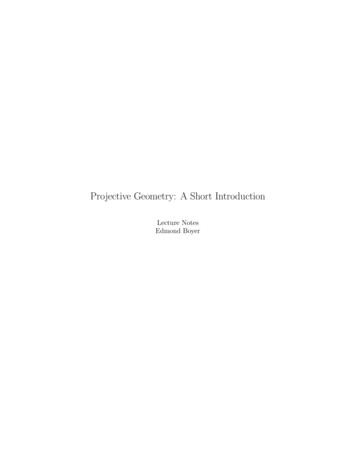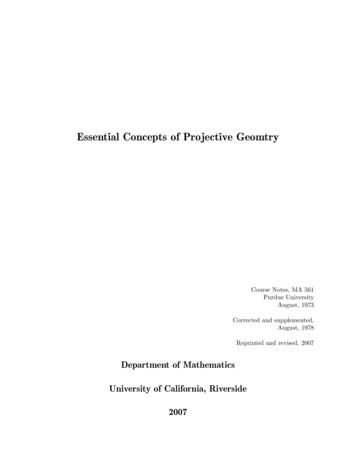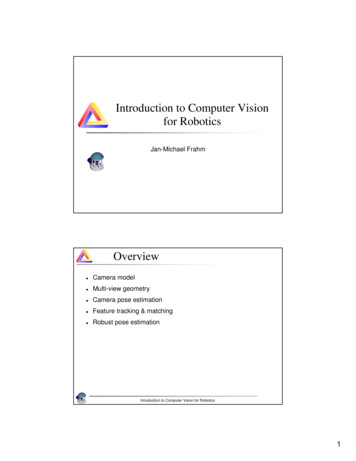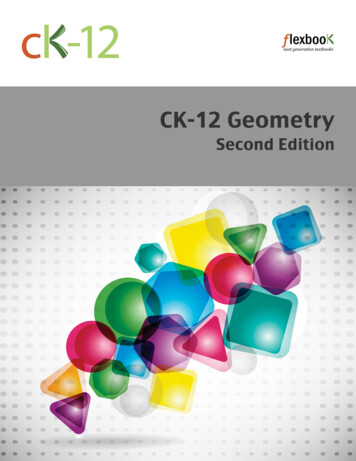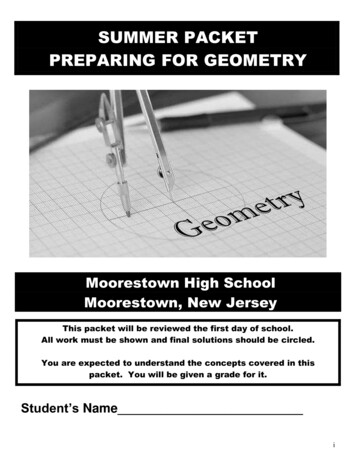
Transcription
Perspective Drawingand Projective GeometryCapstoneWeiPing Li
The Renaissance was a cultural movement thatprofoundly affected European intellectual life inthe early modern period (15th century).Beginning in Italy, and spreading to the rest ofEurope by the 16th century, its influence was feltin literature, philosophy, art, music, politics,science, religion, and other aspects of intellectualinquiry. Renaissance scholars employed thehumanist method in study, and searched forrealism and human emotion in art. Humanistsasserted "the genius of man . the unique andextraordinary ability of the human mind."
One of the distinguishing features ofRenaissance art was its development of highlyrealistic linear perspective. Giotto di Bondone(1267–1337) is credited with first treating apainting as a window into space, but it was notuntil the demonstrations of architect FilippoBrunelleschi (1377–1446) and the subsequentwritings of Leon Battista Alberti (1404–1472)that perspective was formalized as an artistictechnique. The development of perspective waspart of a wider trend towards realism in the artsand reflecting the general world view of peopleconnected to it.
Painting not using Perspective Method:Initial word panel of Psalm
Perspective method not used
Perspective method not used
Perspective method not used
Perspective method not used
Perspective method used:Masaccio, Trinity
Perspective method used
Perspective method used: Leonardo Da Vinci:Adoration (unfinished)
Perspective method usedDonatello: St. George and the Dragon
Perspective method usedDonatello: The Feast of Herod
Perspective method usedDonatello: The Feast of Herod
Artists such as Masaccio strove to portray the humanform realistically, developing techniques to renderperspective and light more naturally. Politicalphilosophers, most famously Niccolò Machiavelli,sought to describe political life as it really was, and toimprove government on the basis of reason.The Renaissance could be viewed as an attempt byintellectuals to study and improve the secular andworldly, both through the revival of ideas fromantiquity, and through novel approaches to thought.
Perspective DrawingWe think of the canvas as a glass screen. Thelight rays from the object pass through thescreen arriving at viewer’s eye to form animage. Perspective drawing is the sectionproduced by the intersection of the glassscreen with the light rays.
PeopleBrunelleschi (1377-1446):discovered/inventedperspective drawingBrunelleschi ‘s friends were the forerunners:Masaccio (1401 -1428)Masolino (1384-1447)Donatello (1386-1466)Alberti (1404-1472) published Della Pittura topopularize method of perspective drawing.
Bronze statue of Fillipo Brunelleschi
Brunelleschi: Santa Maria della Fiore, the Duomo, theBaptistry
Leon Battista Alberti (1404—1474)
Della Pittura
The method of perspective drawing is developed fromgeometric principles in projecting 3-dim object onto 2dim plane.
Dürer perspective drawing device
Dürer perspective drawing device
Dürer perspective drawing device
Erwin Panofsky: Perspective method translatespsychophysiological space into mathematicalspace. It objectivizes the subjective.Why did people in Renaissance embraceperspective method?
Religion Roger Bacon (1220-1292) thought that followinggeometric principles was to spread the grace of god. Renaissance painters thought that linear perspectivecould help to re-establish the moral authority of thechurch. Alberti had the conviction that the beauties of the artscorrespond to a moral and spiritual equilibrium ofhuman existence. Linear perspective, with its dependence on geometricprinciples, seemed to symbolize a harmoniousrelationship between mathematical tidiness and God’swill.
Economics, Education Because of the development of banking, manyschools in Florence taught basic algebra andbookkeeping. In bookkeeping, numerals have to be arrangedin order. This practice made Florence citizensto think that the visual world could also bearranged in an orderly way. Renaissance artists all mastered mathematics.
Vanishing point
Vanishing point
In perspective drawing, for parallel lines thatmeet the canvas, its rendering will meet at onepoint in the canvas called the vanishing point.All vanishing points form a straight line calledthe horizon in the painting.
Ancient Angora, Athens
The Renaissance painters use the vanishing pointas a narrative tool in guiding observers’attention to the important part of the painting.
Masaccio: Tribute Money
Masaccio: Tribute Money
Masolino: Healing of the Cripple and Rising of Tahitha
Neroccio de’Landi: Annunciation
Neroccio de’Landi: Annunciation
Da Vinci: The Last Supper
Da Vinci: The Last Supper
Da Vinci: The Annunciation
Carpaccio:The Disputation of St. Stephen
Dali: Christ of St John of the Cross
Dali: Christ of St John of the Cross
Projective GeometryDesargues (1591-1661):Perspective drawing methodinspired the development ofProjective Geometry.
Family of parallel lines
Real Projective Plane:To every family of parallel lines an ideal pointat infinity is added to represent the intersectionof the family of parallel line at “infinity”. Allthe ideal points form a “line at infinity”.
In perspective drawing, the “horizon” is the “line atinfinity” in projective geometry.For an painter,* perspective image of a straight line is a straight line* parallel lines that are parallel to the canvas, theirperspective images are parallel lines on the canvas.* parallel line that are not parallel to the canvas willmeet at a vanishing point on the canvas.* vanishing points form the line of horizon.
(Real) Projective GeometryThe Projective Plane is obtained from the Euclideanplane by adding the points at infinity and the line atinfinity that is formed by all the points at infinity. Inthis geometry, any two lines will meet at one point.The (real) projective plane can also be obtained froman algebraic construction. If we use complex numbersin this construction, we get the complex projectivespaces. Complex projective spaces have much nicerproperties. For example, the Calabi-Yau Universe is a3-dimesional complex manifold in the 4-dimensionalcomplex projective space.
Projective plane (real)
Calabi-Yau universe
Desargues Theorem
People. Brunelleschi (1377- 1446):discovered/invented perspective drawing. Brunelleschi ‘s friends were the forerunners : Masaccio (1401 -1428) Masolino (1384-1447) Donatello (1386-1466) Alberti (1404-1472) published Della Pittura to p
